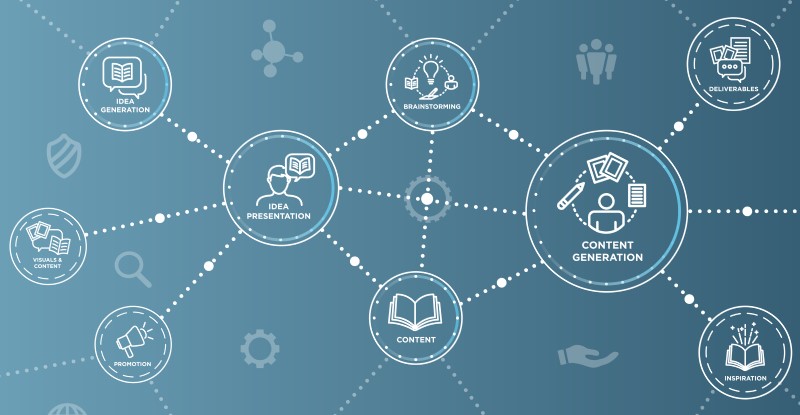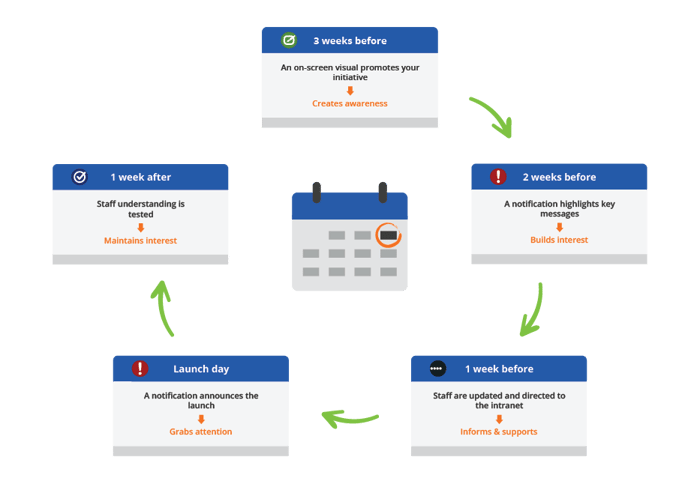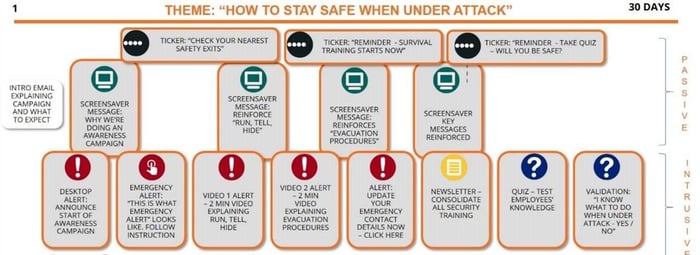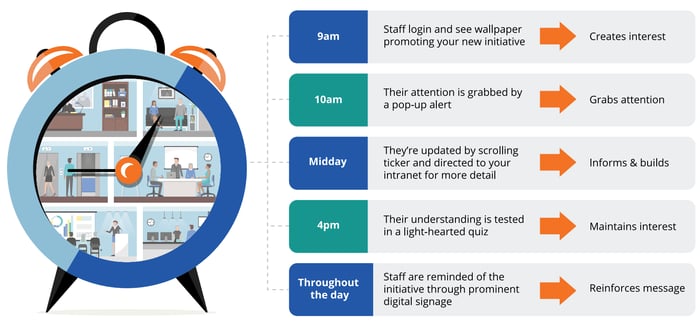
We’re exposed to messages everywhere we go. Whether at home, at work or anywhere in between, a constant stream of information is fed to us. In fact, each person receives about 105,000 words every day. Or put another way, 23 words per second – that’s a lot of information overload.
This explains why our brains are wired to filter out so much of this information. And why internal communicators need to work harder than ever to get employee attention.
Messages need several repetitions to be noticed and even more to influence behavior change. That’s why advertisers are so fond of the ‘rule of 7’ when it comes to advertising effectiveness. It’s equally true in the workplace.
For your internal communications to really hit the mark, kiss goodbye to the ‘one and done’ style of communications. Say hello to campaigns.
Why Internal Communication Campaigns?
Single messages delivered through a single channel are rarely effective for reaching employees. They’re busy performing their jobs and don’t welcome distractions. Communication campaigns resolve this by focusing on frequency and format.
Higher message frequency builds employee awareness. A broader channel mix improves understanding and ultimately drives outcomes.
Communication Campaigns = Higher Frequency x Broader Channel Mix
As internal communicators, we seek to achieve one of two objectives: to drive action, or influence change. Priority notifications demand high visibility and immediate action. Employee behavior change or workplace culture change are slower-burn, requiring longer-term message exposures.
A campaign approach aligns to each objective by reaching employees enough times that the message cuts through, and in enough compelling ways that understanding drives outcomes.
Adopting a campaign approach to your internal communications:
-
Drives behavior change via ongoing drip communications
-
Guarantees delivery, readership, and measurability
-
Cuts through workplace noise, ensuring important messages get noticed
-
Ensures acknowledgment and acceptance of important messages

What Makes Campaigns Work?
Repetition through multiple channels reinforces the message and builds cut-through. A Harvard business study proved that managers who sent a message multiple times and through different media got their projects completed faster and more smoothly than those who did not.
A multi-channel approach makes the best use of the attributes of each. In this way, the effectiveness of priority messaging is lifted through prior message conditioning via passive formats.
When single messages are effective, it’s because previous messages have ‘seeded’ information with employees that develops into understanding. Multi-channel campaigns work because they use the whole communication spectrum to leverage the unique attributes of each channel.
Campaign structure is a strong influence on communication success. An internal communications campaign consists of a series of messages, typically made up of multiple ‘nurture’ messages and a single ‘validation’ message.
Nurture messages deliver information and build awareness by nurturing employees towards knowledge and behavioral change.
Validation messages at the end of a campaign require employees to comply, acknowledge or validate their understanding.
The effectiveness of campaigns lies in their ability to deliver, track and measure communication activities over time. Important company messages are delivered to the right people at the right time, every time.
Internal Communication Campaigns Best Practice
To get the most out of an internal communications campaign, take a more strategic or holistic view. It’s an approach that Chris Leonard, SnapComms CEO, calls 360-degree campaigns.
“Take a campaign approach to your end-to-end employee communications,” he says. “I firmly believe 360-degree campaigns are more important than ever in today’s noisy, info-overloaded business world.”
This framework requires understanding employees’ mindsets through the whole engagement process – both information and emotional mindsets. Messaging and implementation can then be aligned to target each stage and drive positive outcomes.
For communicators, this means reaching employees at times of greatest responsiveness (such as the beginning of the day or the start of shifts) and reaching them through dedicated channels appropriate for different environments (such as mobile for field-based staff or digital signage for non-desk workers).
The following example shows a 360-degree campaign in action:

Best practice for internal communication campaigns requires optimizing channel selection and message delivery to influence employee engagement.
This compressed timeline of a typical day in the life of a corporate office illustrates how complementary channels reinforce each other for greater communication success.

Internal Communication Campaigns Scenarios
The SnapComms platform delivers compelling content across multiple channels to improve your communication campaign initiatives. It’s a solution that delivers to the needs of every business team.
-
Drive behavior change over time and measure the impact
-
Repeat and reuse standard communication campaigns over time
-
Internal product launch campaigns including education and knowledge testing
For IT and Information Security:
-
Educate staff on processes to maximize productivity in times of IT outages
-
Deliver and repeat security awareness campaigns and measure their impact
-
Generate buzz and influence opinion around digital transformation projects
For Human Resources:
-
Lift employee engagement by promoting initiatives and fostering participation
-
Influence positive workplace culture change
For Compliance:
-
Create a culture of compliance
-
Educate and influence compliance and ethical behavior
Looking for more resources to help your internal communications planning? Download our internal communications strategy template for free tips and templates you can use.


